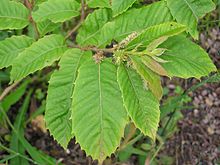Castanea seguinii
Castanea seguinii, the Seguin chestnut (茅 栗, mao li in Chinese) is a species belonging to to the Fagaceae family.
Description
They are small trees or shrubs, rarely reaching 12 m in height. The stipules are narrowly lanceolate, 0.7-1.5 cm, deciduous at fruiting. The leaves have a 0.5-1.5 cm petiole with an oblong-obovate to elliptic-oblong blade, 6-14 cm long, with the underside covered with brown or greyish-yellowish scale-shaped glands and sparsely hairy along the length. nerves when young; They have a rounded to subcordate base, but cuneiform when young, with a roughly serrated margin and a pointed apex. The male catkins are 5-12 cm, and the female inflorescences have a solitary flower or a few flowers per dome. These domes measure 3-5 cm in diameter and are covered with sparsely hairy spines of 6-10 mm. There are the same number (1 or 3) achenes per infructescence as there are flowers per cupule and they measure 1.5-2 cm in diameter.
Habitat and distribution
It is a native and endemic species of central and eastern China. It flowers in May-July and bears fruit in September-November in mixed forests, scrub, and in orchards at altitudes between 400 and 2,000 m.
Taxonomy
Castanea seguinii was described by Louis-Albert Dode and published in Bulletin de la Societe Dendrologique de France, 8: 152, f. s.n., 1908.
- Etymology
- Castanea: generic name derived from the Greek χετανον And then the Latin castăněa, -ae, name of chestnut and chestnut (Virgilio, Bucolicas,1, 82), the latter also called castanea nux (Virgilio, Bucolicas, 2, 52), the walnut of the chestnut. It could also derive from Castanaea, ae or Castana, ae, city of Asia Minor or, according to others, of the Armenian name of this tree.
- seguinii: epithet alluding a certain Seguin, an unknown character, probably an explorer in China, as the author of the species was particularly active in describing and documenting materials introduced to France of arboreta Chinese.
- Sinonimia
- Castanea davidii Dode, Bull. Soc. Dendrol. France1908, p. 153, 1908
Uses
Extensively and intensively cultivated in China for its edible nuts, but not as widely as Castanea mollissima.
Contenido relacionado
Fagaceae
Erythroxylaceae
Cynodon

